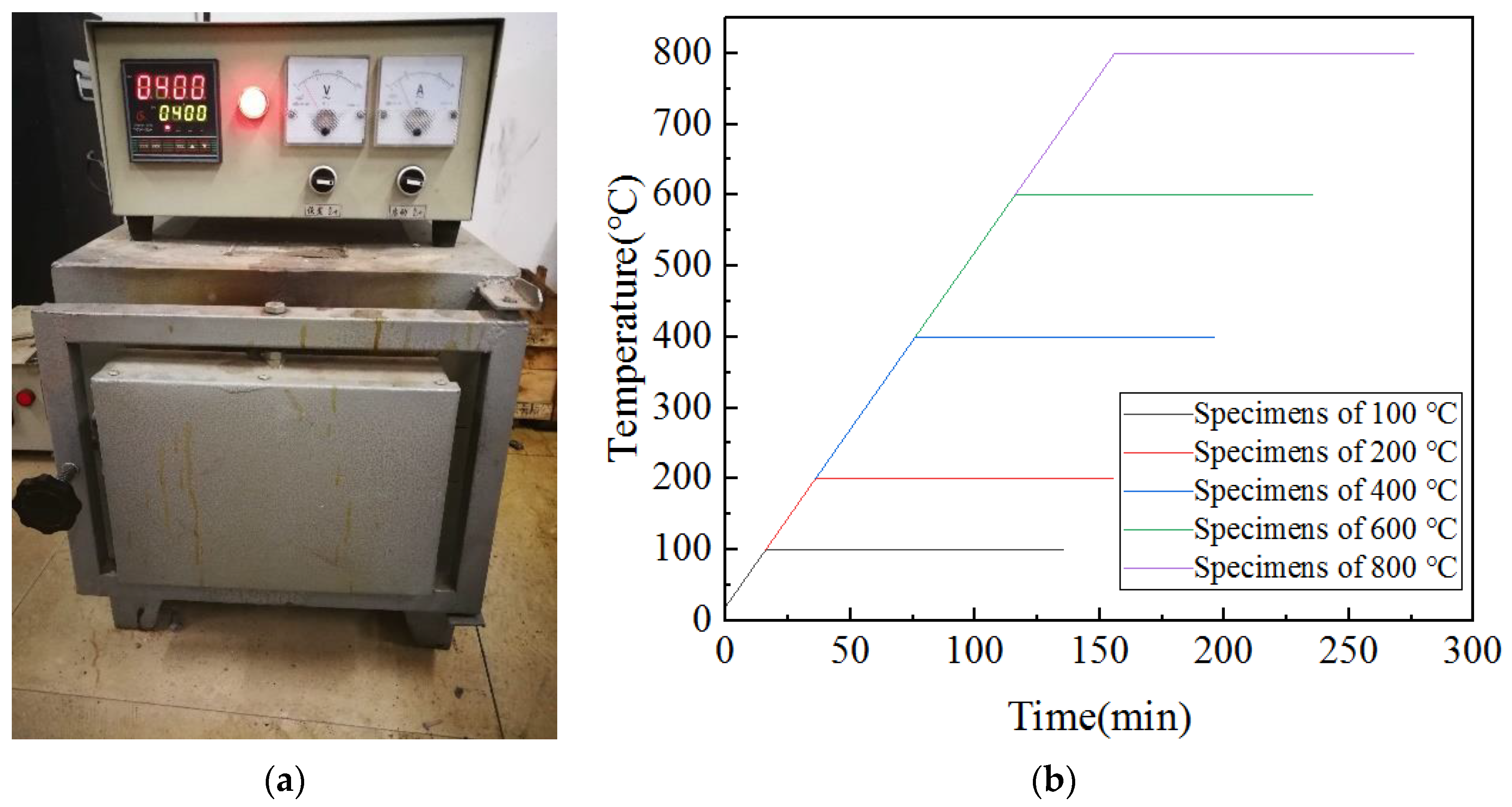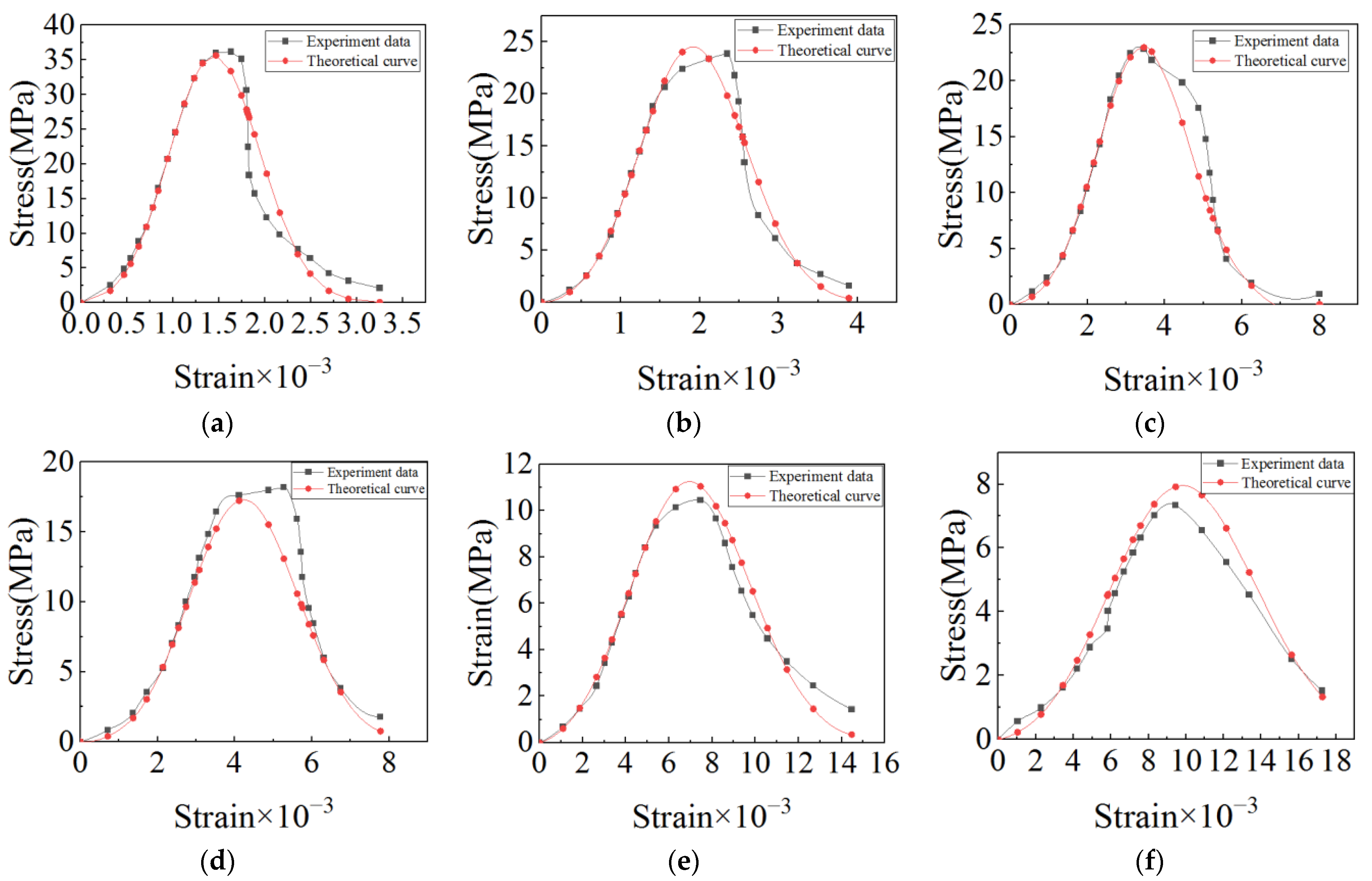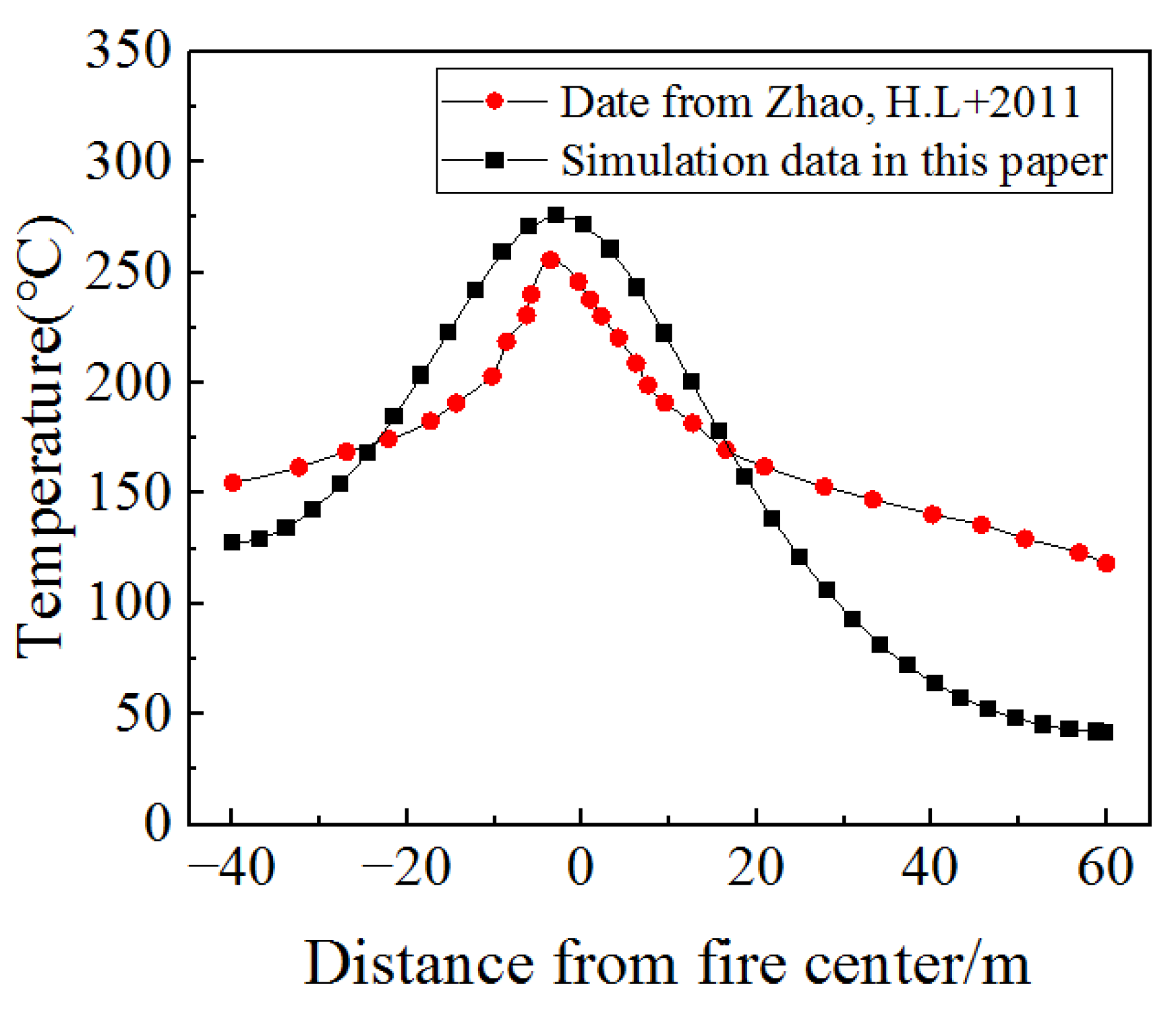Analysis on Damage and Mechanical Properties of Ballastless Track in a Tunnel after a Fire
Abstract
:1. Introduction
2. Uniaxial and Shear Tests
2.1. Test Preparation
2.2. Test Method
3. Test Results and Analysis
3.1. Stress–Strain Curve of the Uniaxial Compressive Test
3.2. Elastic Modulus
3.3. Relationship between Uniaxial Compressive Strength and Temperature
3.4. Damage Value of Concrete after High-Temperature Heating
- (1)
- Damage calculation using “residual strength” thermal damage model
- (2)
- Damage calculation using elastic modulus
3.5. High-Temperature Damage Constitutive Equation for Concrete
3.6. Shear Strength
4. Temperature Field and Mechanical Properties of a Ballastless Track Structure in a Tunnel during a Fire
4.1. The Geometric Dimensions of the Model
4.2. Initial and Boundary Conditions of the Model
4.3. Temperature Field of a Ballastless Track Structure in a Tunnel during a Fire
4.4. Mechanical Properties of a Ballastless Track Structure at Different Positions after a Tunnel Fire
5. Conclusions
- ▪
- Taking 20 °C as the benchmark, when the temperature reaches 100 °C, 200 °C, 400 °C, 600 °C, or 800 °C, the uniaxial compressive strength, elastic modulus, peak strain, and shear strength of concrete changes after the increase in temperature as follows: the uniaxial compressive strength decreases by 34.00%, 36.85%, 49.68%, 71.09%, or 79.70%, respectively; the elastic modulus decreases by 43.03%, 46.44%, 71.21%, 81.42%, or 91.95%, respectively; the peak strain increases by 44.17%, 112.27%, 223.31%, 357.67%, or 479.75%, respectively; and the shear strength decreases by 2.52%, increases by 9.86%, or decreases by 35.78%, 53.90%, or 62.61%, respectively.
- ▪
- Based on the mechanical testing of concrete after exposure to high temperatures, the high-temperature damage constitutive equation for concrete was established, and the stress–strain curves of concrete under uniaxial compressive after exposure to high temperatures were accurately simulated.
- ▪
- FLUENT was used to simulate the temperature field of the cast-in-place C35 concrete track bed when a fire occurs in a tunnel. The surface of the track bed near the fire carriage had the highest temperature. Combined with the high-temperature damage constitutive equation for concrete and the formula for damage fitting, the strength and damage values of the track bed slab at different positions after a tunnel fire can be obtained quickly and accurately, which can provide a theoretical basis for post-disaster assessment and reinforcement of the track structure.
Author Contributions
Funding
Institutional Review Board Statement
Informed Consent Statement
Data Availability Statement
Conflicts of Interest
References
- Husem, M. The effects of high temperature on compressive and flexural strengths of ordinary and high-performance concrete. Fire Saf. J. 2006, 41, 155–163. [Google Scholar] [CrossRef]
- Gao, D.Y.; Zhao, L.P.; Chen, G. Flexural behavior of fiber and nanoparticle reinforced concrete at high temperatures. Fire Mater. 2018, 42, 725–740. [Google Scholar] [CrossRef]
- Lee, J.; Xi, Y.P.; Willam, K. Properties of concrete after high temperature heating and cooling. Aci Mater. J. 2008, 105, 334–341. [Google Scholar]
- Lee, J.S.; Xi, Y.; Willam, K. Strength and stiffness of concrete under heating and cooling treatments. In Proceedings of the Proceedings of the 6th International Conference on Fracture Mechanics for Concrete and Concrete Structures, Catania, Italy, 17–22 June 2007. [Google Scholar]
- Memon, S.A.; Shan, S.F.A.; Khushnood, R.A. Durability of sustainable concrete subjected to elevated temperature—A review. Constr. Build. Mater. 2019, 199, 435–455. [Google Scholar] [CrossRef]
- Rozsypalova, I.; Danek, P.; Simonova, H. A Pilot Study of Methods for Measuring the Residual Properties of Concrete Exposed to Elevated Temperatures. Mater. Tehnol. 2018, 52, 243–252. [Google Scholar] [CrossRef]
- Wroblewska, J.; Kowalski, R. Assessing concrete strength in fire-damaged structures. Constr. Build. Mater. 2020, 254, 9. [Google Scholar]
- Huo, J.S.; He, Y.M.; Xiao, L.P. Experimental study on dynamic behaviours of concrete after exposure to high temperatures up to 700 A degrees C. Mater. Struct. 2013, 46, 255–265. [Google Scholar] [CrossRef]
- Toric, N.; Boko, I.; Peros, B. Degradation of mechanical properties of high-strength concrete after exposure to fire. Gradevinar 2011, 63, 1033–1041. [Google Scholar]
- Xu, Z.S.; Xie, B.C.; Duan, X.W. Experimental Research on Fire Damage of Tunnel Lining Concrete Test Blocks. Prog. Saf. Sci. Technol. 2010, 8, 690–696. [Google Scholar]
- Neuenschwander, M.; Knobloch, M.; Fontana, M. Suitability of the damage-plasticity modelling concept for concrete at elevated temperatures: Experimental validation with uniaxial cyclic compression tests. Cem. Concr. Res. 2016, 79, 57–75. [Google Scholar] [CrossRef]
- Rafi, M.M.; Aziz, T.; Lodi, S.H. Effects of Elevated Temperatures on Residual Properties of Low-Strength Concrete. J. Test. Eval. 2019, 47, 3448–3469. [Google Scholar] [CrossRef]
- Le, Q.X.; Torero, J.L.; Dao, V.T.N. Stress-strain-temperature relationship for concrete. Fire Saf. J. 2021, 120, 6. [Google Scholar] [CrossRef]
- Nuaklong, P.; Boonchoo, N.; Jongvivatsakul, P. Hybrid effect of carbon nanotubes and polypropylene fibers on mechanical properties and fire resistance of cement mortar. Constr. Build. Mater. 2021, 275, 122189. [Google Scholar] [CrossRef]
- Sukontasukkul, P.; Pomchiengpin, W.; Songpiriyakij, S. Post-crack (or post-peak) flexural response and toughness of fiber reinforced concrete after exposure to high temperature. Constr. Build. Mater. 2010, 24, 1967–1974. [Google Scholar] [CrossRef]
- Sukontasukkul, P.; Nimityongskul, P.; Mindess, S. Effect of loading rate on damage of concrete. Cem. Concr. Res. 2004, 34, 2127–2134. [Google Scholar] [CrossRef]
- Ji, J.; Tian, T.T.; Gao, Z.H. Numerical Investigation on the Influence of Length-Width Ratio of Fire Source on the Smoke Movement and Temperature Distribution in Tunnel Fires. Fire Technol. 2019, 55, 963–979. [Google Scholar] [CrossRef]
- Liu, B.; Mao, J.; Xi, Y.H. Effects of altitude on smoke movement velocity and longitudinal temperature distribution in tunnel fires. Tunn. Undergr. Space Technol. 2021, 112, 10. [Google Scholar] [CrossRef]
- Li, Y.F.; Bian, J.; Li, J.M. Research on Smoke Flow in a Tunnel Fire of Subway System. Procedia Eng. 2014, 71, 390–396. [Google Scholar] [CrossRef]
- He, G.H.; Gong, Y.J.; Tang, H. Tunnel fire simulation based on FDS. In Proceedings of the 7th International Conference on Fluid Power Transmission and Control (ICFP 2009), Hangzhou, China, 7–10 April 2009. [Google Scholar]
- Li, J.M.; Liu, X.; Fu, C.Y. Numerical Simulation on Fire Environment in Urban Traffic Tunnel. Prog. Saf. Sci. Technol. 2010, 8, 632–638. [Google Scholar]
- Qu, Z.M.; Wang, X.L. 3-D Numerical Simulation of Smoke Flow during Tunnel Fire. In Proceedings of the 2009 International Conference on Measuring Technology and Mechatronics Automation, Zhangjiajie, China, 11–12 April 2009. [Google Scholar]
- Lu, G.D.; Qu, Z.M.; Li, J.X. Numerical Investigation on Tunnel Fire Smoke Flow. Prog. Saf. Sci. Technol. 2008, 7, 653–657. [Google Scholar]
- Lu, K.H.; Xia, K.H.; Shi, C.L. Investigation on the Tunnel Curvature Effect upon the Ceiling Temperature of Tunnel Fires: A Numerical Simulation. Fire Technol. 2021, 57, 2839–2858. [Google Scholar] [CrossRef]
- Li, Z.; Luo, Y.; Gao, Y.; Yang, X.; Guo, H.; Zhang, Y. Experimental and Theoretical Studies of the Effects of Fire Location on the Smoke Temperature Distribution in a Branched Tunnel. Fire Technol. 2022, 58, 1265–1284. [Google Scholar] [CrossRef]
- Qu, Z.M.; Ma, X.Y. Numerical Simulation of Smoke Flow and its Effect during Railway Tunnel Fire. In Key Engineering Materials; Trans Tech Publications Ltd.: Wollerau, Switzerland, 2010. [Google Scholar]
- Sukontasukkul, P.; Jamnam, S.; Sappakittipakorn, M. Residual flexural behavior of fiber reinforced concrete after heating. Mater. Struct. 2018, 51, 98. [Google Scholar] [CrossRef]
- Shen, Q.C.; Chen, W.; Liu, C.; Zou, W.J. The Tensile Strength and Damage Characteristic of Two Types of Concrete and Their Interface. Materials 2020, 13, 16. [Google Scholar] [CrossRef] [Green Version]
- Li, B.J.; Li, X.; Wang, Y.; Yin, T.B. Influence of temperature shock on dynamic tensile mechanical properties of granite. Gold Sci. Technol. 2021, 29, 545–554. [Google Scholar]
- Chen, Z.P.; Wang, H.H.; Chen, Y.L. Experimental study on mechanical properties of concrete after high temperature. Concrete 2015, 1, 13–17. (In Chinese) [Google Scholar]
- Lv, T.Q.; Zhao, G.F.; Lin, Z.S. Experimental study on mechanical properties of statically placed concrete after high temperature. J. Build. Struct. 2004, 1, 63–70. (In Chinese) [Google Scholar]
- Luo, Y.S.; Chen, C.; Tang, S.H. Testal study on compressive strength of concrete under high temperature. J. Nat. Sci. Xiangtan Univ. 2013, 35, 30–34+40. (In Chinese) [Google Scholar]
- Jiang, L.H. Testal Study on Mechanical Properties of High Temperature Concrete; University of Shanghai for Science and Technology: Shanghai, China, 2011. (In Chinese) [Google Scholar]
- Jia, B.; Yang, F.; Tao, J.L. High temperature mechanical properties and constitutive equations of concrete. Concrete 2014, 2, 25–28+32. (In Chinese) [Google Scholar]
- Chen, C.K.; Kang, H. Numerical simulation of fire temperature field in heavy-duty railway tunnels under conditions of extremely rich combustibles. Fire Sci. 2013, 22, 24–30. (In Chinese) [Google Scholar]
- Sun, X.P. Analysis of Cracking Mechanism of Ballast Slab Concrete; Central South University: Changsha, China, 2010. (In Chinese) [Google Scholar]
- Wang, S.Y. Research on the Distribution Law of fire Temperature Field in Expressway Tunnel; Chang’an University: Xi’an, China, 2013. (In Chinese) [Google Scholar]
- Zhao, H.L.; Xu, Z.S.; Jiang, X.P. Experimental and Numerical Simulation Research on Temperature Distribution of Tunnel Fire. In Proceedings of the 2011 Academic Annual Conference of China Occupational Safety and Health Association, Liuzhou, China, 19–20 October 2011; pp. 371–377. (In Chinese). [Google Scholar]
















| Mixtures | Dosage |
|---|---|
| Cement (kg/m3) | 227 |
| Water (kg/m3) | 149 |
| Fine sand (kg/m3) | 795 |
| Coarse aggregate (kg/m3) | 1098 |
| Limestone powder (kg/m3) | 68 |
| Slag (kg/m3) | 44 |
| Admixture (kg/m3) | 6.4 |
| Temperature/°C | 20 | 100 | 200 | 400 | 600 | 800 |
|---|---|---|---|---|---|---|
| Peak stress/MPa | 36.15 | 23.86 | 22.83 | 18.19 | 10.45 | 7.34 |
| Peak strain /10−3 | 1.63 | 2.35 | 3.46 | 5.27 | 7.46 | 9.45 |
| Temperature/°C | 20 | 100 | 200 | 400 | 600 | 800 |
|---|---|---|---|---|---|---|
| Elastic modulus ET × 104/MPa | 3.23 | 1.84 | 1.73 | 0.93 | 0.60 | 0.26 |
| Temperature/°C | 20 | 100 | 200 | 400 | 600 | 800 |
|---|---|---|---|---|---|---|
| Uniaxial compressive strength fc(T)/MPa | 36.15 | 23.86 | 22.83 | 18.19 | 10.45 | 7.34 |
| The reduction rate of uniaxial compressive strength/% | 0.00 | 34.00 | 36.85 | 49.68 | 71.09 | 79.70 |
| Temperature/°C | 20 | 100 | 200 | 400 | 600 | 800 |
|---|---|---|---|---|---|---|
| Damage value D1(T) | 0.0717 | 0.2210 | 0.3700 | 0.5757 | 0.6999 | 0.7749 |
| Damage value D2(T) | 0.0448 | 0.3136 | 0.5329 | 0.7532 | 0.8379 | 0.8705 |
| Temperature/°C | A | |||
|---|---|---|---|---|
| 20 | 0.0008687 | 1.258 | 0.745 | 2 |
| 100 | 0.0005413 | 1.641 | 1.015 | 2 |
| 200 | 0.0003475 | 2.973 | 1.810 | 2 |
| 400 | 0.0003178 | 3.701 | 2.092 | 2 |
| 600 | 0.0001827 | 5.668 | 4.242 | 2 |
| 800 | 0.0001223 | 8.011 | 5.920 | 2 |
| Temperature/°C | 20 | 100 | 200 | 400 | 600 | 800 |
|---|---|---|---|---|---|---|
| Shear strength/MPa | 4.36 | 4.25 | 4.79 | 2.80 | 2.01 | 1.63 |
Publisher’s Note: MDPI stays neutral with regard to jurisdictional claims in published maps and institutional affiliations. |
© 2022 by the authors. Licensee MDPI, Basel, Switzerland. This article is an open access article distributed under the terms and conditions of the Creative Commons Attribution (CC BY) license (https://creativecommons.org/licenses/by/4.0/).
Share and Cite
Ma, H.; Chen, W.; Li, X.; Xu, Q.; Lou, P.; Tong, C. Analysis on Damage and Mechanical Properties of Ballastless Track in a Tunnel after a Fire. Materials 2022, 15, 6712. https://doi.org/10.3390/ma15196712
Ma H, Chen W, Li X, Xu Q, Lou P, Tong C. Analysis on Damage and Mechanical Properties of Ballastless Track in a Tunnel after a Fire. Materials. 2022; 15(19):6712. https://doi.org/10.3390/ma15196712
Chicago/Turabian StyleMa, Hujun, Wei Chen, Xiang Li, Qingyuan Xu, Ping Lou, and Chencai Tong. 2022. "Analysis on Damage and Mechanical Properties of Ballastless Track in a Tunnel after a Fire" Materials 15, no. 19: 6712. https://doi.org/10.3390/ma15196712





